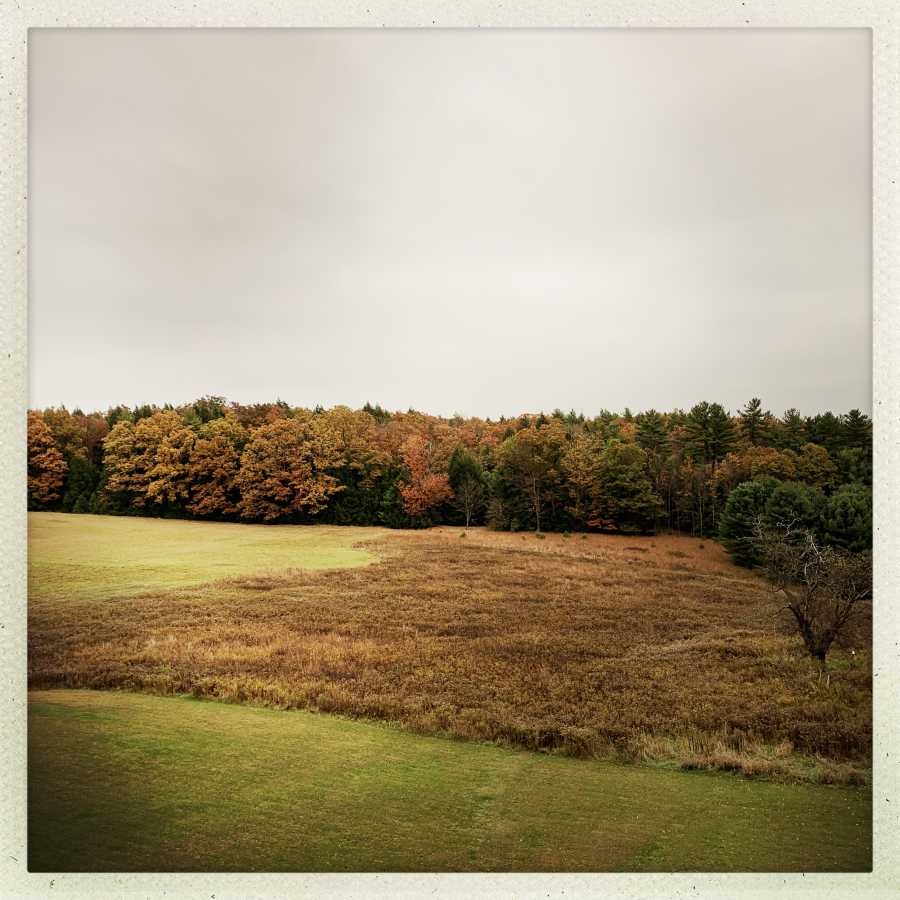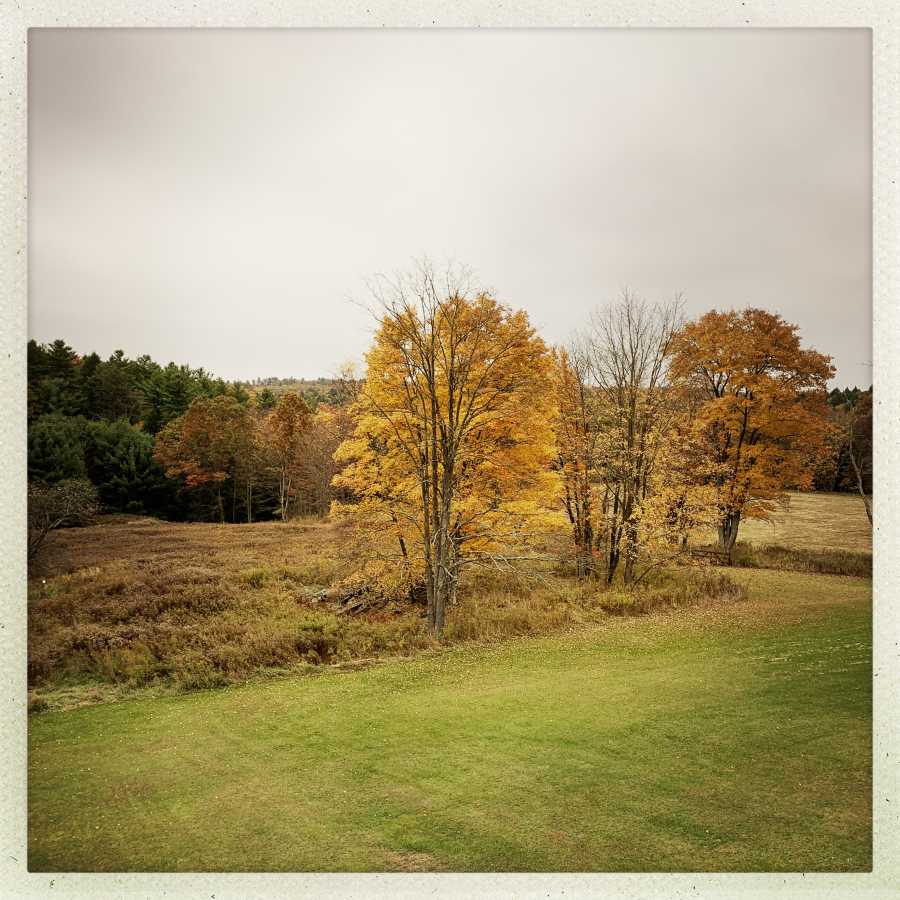Today I’m including a bonus photo of the maples at the back of my yard, where the old horse barn used to stand.
It’s another rainy and overcast day. Perfect to spend in front of a hot fire!

Over by my shop, there’s a fellow who has a couple maple trees that are tapped for syrup. That seems to me to be the sort of thing I could do; it’s just a matter of gear and maybe a propane heat ring? I will research it for next year. I own a lot of maple trees.


What a wonderful view! Makes me want to take a hike through your backyard!
avalus@#1:
What a wonderful view! Makes me want to take a hike through your backyard!
You’d be welcome but you’d have to wear blaze orange. Hunting season is soon and every year I have to chase a few gun-toting jackasses out of my yard.
So in that second photo, the trees in blaze yellow are sugar maples? So beautiful.
We just lost a big, very old tree and I’m looking for a possible, not replacement exactly because the root structure from the old tree means we have to plant elsewhere, but another tree for shade. I’m not sure if a sugar maple would grow here, though.
@kestrel: I don’t know the growing range of sugar maple. I think they like it cool and sunny.
I grew up in PA, and remember some small farms would tap their own maples in the spring.
There’s a section on it in one of my books: Reader’s Digest Back to Basics. I picked it up at a library book sale, and it’s got a lot of good info for homesteading and such.
Anyways, it’s saying a good tree should yield 15-20 gallons of sap, which you would then boil down to 2 quarts…
don’t tapp trees under 10″, trees over 2 ft can have ~4 taps, South side is best, tap 2-6ft above ground, 2-3″ into sapwood at a ~10-20 degree upward angle. Collect sap in covered containers, can be stored outside for up to 3 days as long as it’s cold.
Start boiling as soon as you’ve collected a decent amount, boil outside, using wood takes ~1/4 cord to make 4 gallons syrup. Syrup is done when the boiling point is 7degrees Fahrenheit over water boiling temp (so, 219F at sea level…). Also need to filter during the process, as there is some calcium compound called “sugar sand” that develops. The book recommends using mason jars, pouring the syrup at least 180F and sealing.
Sugar and Black Maples are the best, but Norway Maple isn’t bad. Other maples can be used, but won’t be as productive. Not mentioned in the book, but I vaguely remember something from some primitive-skills/survival book that you can also use birch sap in a similar manner.
I imagine you could find a lot better info…
In Latvia very few people make maple syrup. It is possible to make a syrup from the maple and birch trees that grow here, but people just don’t do it. Making your own at home is a pretty big hassle, but making it commercially is apparently not happening on a large scale.
Instead here people drink maple and birch juice as a drink. It takes no preparation at all, once you get the juice out of a tree, you just drink it. Since fresh maple or birch juice has a pretty short shelf life, people routinely freeze it for storage.
Personally, I like the taste of birch juice. It’s certainly tastier than water. I also find maple juice pretty tasty, but I definitely prefer birch juice, hence that’s what I drink every spring. There are some birch trees on my boyfriend’s property, so I can even get it for free. Although buying it is actually pretty cheap, here one liter of maple or birch juice costs about one euro at the farmers’ market.
Sugar maples especially are a double treat – they give maple sugar and some of the best fall foliage. Of course, if you have a garden, their little helicopter seeds tend to produce a thousand little maples that you have to weed, but that’s just nature.
@Andreas Avester – there is a thing in the US called birch beer. It’s birch juice that’s boiled and fermented. Root beer is related – sassafrass root boiled, sugared, and fermented.
I made ginger/rootbeer once and put too mich sugar in, so I had to haul 2 cases of bottles into the yard, put them in a cardboard box and triple bag it, then shot it with a .22 (fired through a soda bottle because I was in the city at the time) it exploded so violently the box was blown apart and I was glad I was wearing motorcycle leathers and a helmet – everything got sticky.
Marcus Ranum #8
you assassinated a case of root beer, with a 22, because … why?
@chigau:
Oh! I did not fully explain!
The key bit is “I put too much sugar” – when making a carbonated brew, if there is too much food for the yeast you wind up with too much carbon dioxide. I went down to check on my bottles and the steel bottle caps were BULGING there was so much pressure behind them. Each glass bottle was effectively a compressed gas-powered hand grenade. I had the leathers and helmet on in case one of the bottles clinked against another and detonated.
@Marcus #2: I would have to get to USA-Land before, anyways. I can’t see that happening for a while. Gun-toting jackasses are a great dampener to outdoor fun.
Marcus Ranum@8
Going off on a bit of a tangent here, but out of idle curiosity, how well did the makeshift soda bottle suppressor work?
but seeing bulging bottlecaps would certainly be concerning. Enough that I can’t imagine I would want to handle them, I’d likely just cover them in towels and blankets, and hope that would contain the shrapnel…
lochaber@#12:
Going off on a bit of a tangent here, but out of idle curiosity, how well did the makeshift soda bottle suppressor work?
Oh, they work great. I actually made a really nice version, at one time, which I have since lost – a delrin collar that fit over the barrel of my Ruger MKII, which could be easily held in place with some tape, and a 2L bottle just screwed right into the end. The first shot is muffled very well; subsequently, some of the shockwave leaks out but really the sound is transformed from the bang of the gun to the whoomp of the bottle expanding.
Now I am thinking that my iPhone has an app that measures decibels. I could do some … science.
Around about 2000 one of my buddies came up with a MKII with a commercial suppressor – a fairly high end model. It was seriously impressive. We were shooting at an old satellite dish conveniently mounted on the side of the barn by the former owner of the farm, and the sound of the bullets hitting the dish was louder than the sound of the gun firing. You could shoot someone in the middle of 5th Avenue and nobody’d even hear the shot. My 2-liter disposable suppressor was not a good. The modern suppressors rely on slowing down the muzzle blast gases by forcing them to move pieces of metal in the cannister. Very clever. The 2-liter suppressor does the same thing, forcing the muzzle blast gases to stretch the plastic bottle. You used to be able to buy subsonic .22 and other calibers, as well, though I don’t know the current state of such things. My supply of ammo is good enough that I won’t buy any more the rest of my life.
Up here in Pennsylvania, suppressors are – I think – a 2 week wait for the paperwork. The NRA encouraged Pennsylvania’s republican lawmakers to pass all sorts of absurd laws making sure it’s easy to get stuff for shooting. They aren’t very bright.
[I have it from good authority that the Mossad hit teams use .22s based on having done some perceptive psychiometry and someone discovered that if you change the characteristic sound of a shot by even a moderate amount, most people simply don’t recognize it. They shot Gerald Bull in an elevator in a crowded hotel and nobody noticed a thing.]
Tapping maple trees is something most of the farmers in my area do. Nowadays they mostly use vacuum hosing, but there are still a few places that hang pails. The farm beside the little forest where Jack and I walk uses pails and they host pancake breakfasts on weekends. The smell is amazing when they cook it down. They still do it the old-fashioned way over a wood fire and the aroma permeates the whole forest.